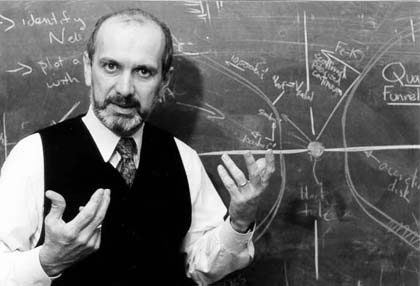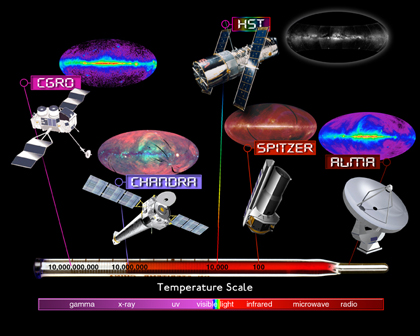General
The Numbers are Just a Tool
Martin Elvis is a senior astrophysicist at the Smithsonian Astrophysical Observatory. When not getting bumped up to business class, he studies quasars and other fascinating phenomena in the Universe with Chandra and other telescopes.

Copyright: Smithsonian Institution, from SI Research Reports
A GPS System for Cosmic Images
Imagine getting a picture of some random patch of the Earth. This picture has some features on it - maybe a mountain or a river or even a city - but from the altitude it was taken, you can't be exactly sure what's what. And then imagine if someone asked you to place it exactly where it should lie on the Earth. Really hard, right?

It's New Hampshire - USA
Well, of course, it gets a lot easier if someone were to give you the exact longitude and latitude. While this seems like an obvious thing to do, it's not so simple for astronomical images. When astronomers create their images for scientific purposes, these images retain certain coordinate information - like longitude and latitude - but for space. Unfortunately, when these images get processed further to make them attractive for the public, this information gets stripped out. In other words, we're back to having no clue where this image matches up with anything else.
Carnival of Space
Many of this week's blogs focused on that little-known telescope that's being invaded by a spaceship. In case you missed it, the telescope is called "Hubble" and the spaceship is our Space Shuttle Atlantis. Naturally, the astro-blogosphere took notice. In his "Dynamic of Cats" blog, Steinn Sigurdsson talks about the last pretty picture to come out of that workhorse instrument with the stubborn screw -- Wide Field/Planetary Camera 2.

The Bigger Picture
Take a look at "The Bigger Picture," a blog produced by the Smithsonian Photography Initiative (SPI). It aims to present an inside look at the Smithsonian's photography collections and invites audiences to engage in an online discussion about photography's powerful impact on our world. We contributed a post on "Seeing the Invisible (part I)" that you might enjoy: http://blog.photography.si.edu/2009/05/11/seeing-the-invisible/
-Kim Arcand, CXC
Chandra's One-time Shuttle Trip
This week, the Space Shuttle Atlantis will return to the Hubble Space Telescope for a fifth and final time. The mission will bring the telescope new instruments, batteries, and gyroscopes that will extend its lifetime for hopefully several years or more.
This year marks the 10th anniversary that the Shuttle launched and deployed Chandra . There haven't been any visits since and none will ever take place. That's because Chandra was designed to be different than Hubble -- in more ways than just the type of radiation it detects.

"Hand"ling Information in Today's World
We've been publicizing and distributing Chandra results for nearly ten years now. One interesting trend we've watched over this time is how much things have changed in how people get their information. Back in the day, we would write a press release - sometimes even printing on paper! – and this would go to science reporters, who, in turn, would write articles for their newspapers, radio programs, or TV reports. The public would generally learn about our results by seeing them through these outlets.
Celebrating Telescopic Diversity
This week, we released a new result that combines data from Chandra with two other telescopes (MacsJ0717.) The truth is that the multiple-telescope approach is  probably no longer the exception - rather it has become the rule.
probably no longer the exception - rather it has become the rule.
Is it Easy Being Green?
Solar panels have been in the news a lot lately. First, the Space Shuttle Discovery launched to bring the final set of solar panels to the International Space Station. Then the astronauts onboard the ISS got a call from an interested member of the public - President Barack Obama - who wanted to talk, among other things, about how the ISS uses solar power to generate its energy.
Well, as it turns out, the ISS is far from the only spacecraft up there using solar power. John Scott, a mission planner for Chandra's Flight Operation Team, describes how NASA's premier X-ray observatory is as green as can be.
Live Webcast from Chandra's Control Center
On Friday, April 3rd, the public will have a chance to get an inside peek at how the Chandra X-ray Observatory is run. That's because we're participating in the "Around the World in 80 Telescopes" project that's part of the International Year of Astronomy's "100 Hours" program.
March's Mission Madness
You may have noticed that NASA is running an event mirroring the annual extravaganza that is the NCAA basketball tournament. Instead of selecting the basketball teams you think will win (I'm rooting for a certain Big 10 team myself), you vote for your favorite NASA mission.



